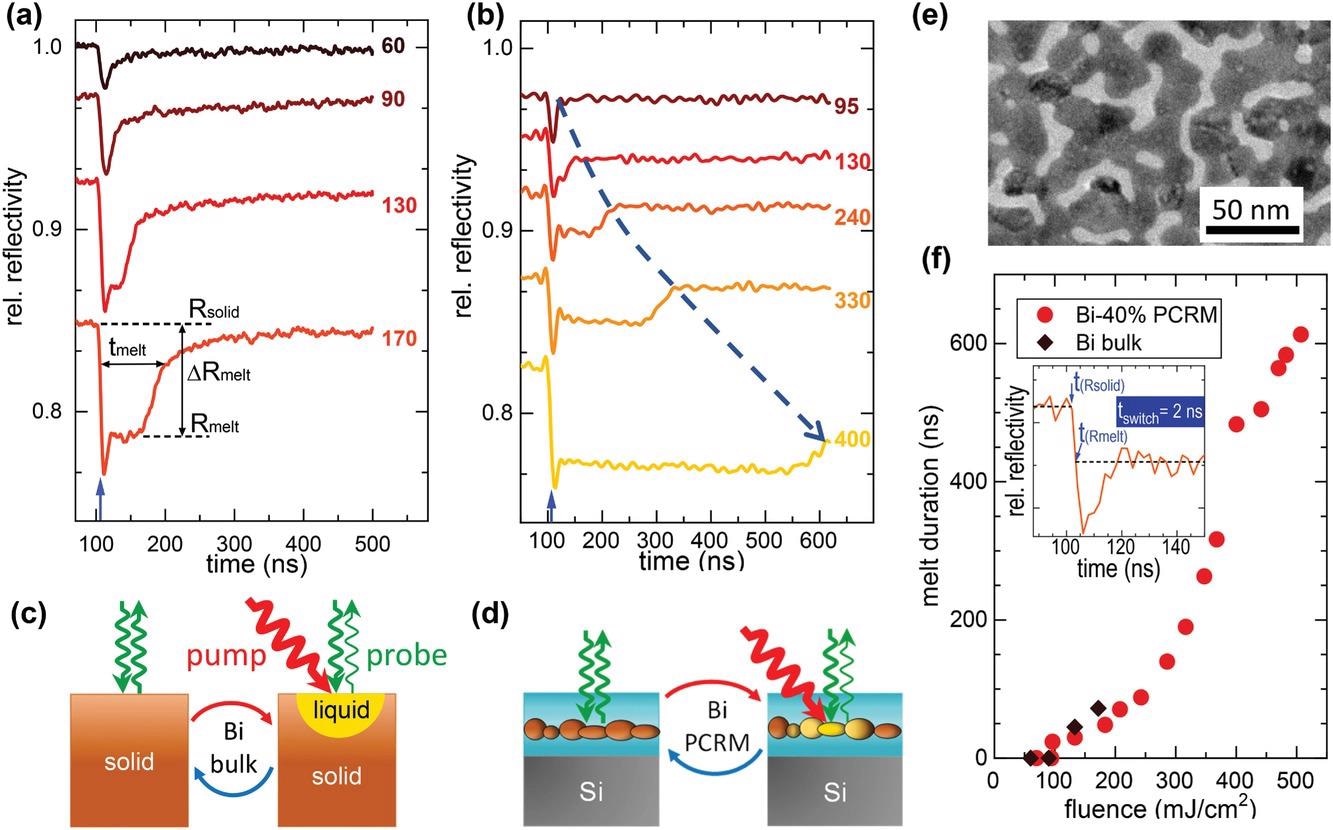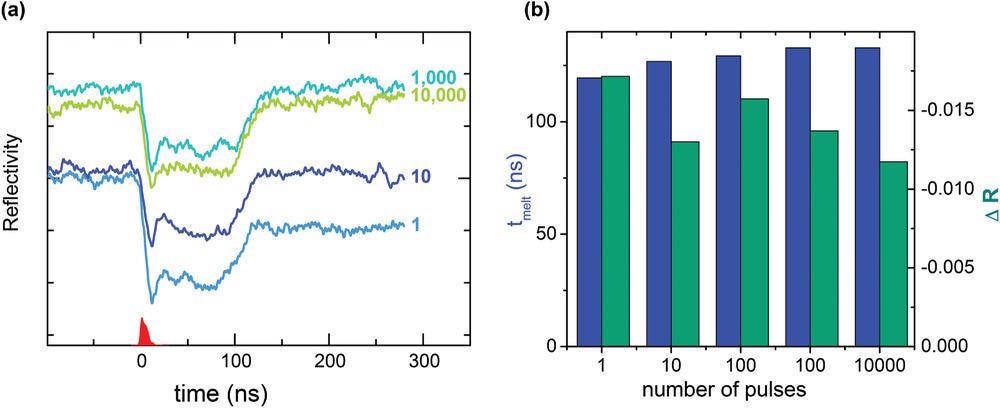Nanocomposites are synthetic material systems made up of two or more different substances that have been constructed at the nanoscale to produce characteristics that are significantly different from the component elements, such as Bismuth. News research has been published in the journal Advanced Optical Materials.

Study: Nanosecond Laser Switching of Phase-Change Random Metasurfaces with Tunable ON-State. Image Credit: Josiah_S/Shutterstock.com
Thin-film nanocomposites are classified as metasurfaces because of their extraordinary flexibility. Metasurfaces have a wide range of applications in critical technical sectors such as telecommunications, energy, chemistry, and healthcare. Within the area of nanophotonics, the usage of metasurfaces generated by planar configurations of metallic and dielectric nanomaterials has permitted the modification and preparation of light at sub-wavelength levels, which is hard to do with organic fibers.

Transient changes of the relative reflectivity at 532 nm of a) bulk Bi and b) a Bi-40% (40% filling factor) phase-change random metasurface (PCRM) on Si substrate upon nanosecond laser irradiation. All curves have the same initial level (Rrel = 1) but have been displaced vertically for better visibility. The initial reflectivity R0 (bulk Bi) is 0.67 and R0 (Bi-40%) is 0.30. Laser fluences are listed in the corresponding legends and given in mJ cm−2. The horizontal dashed lines in panel (a) correspond to the normalized reflectivity of solid and liquid Bi (see the text) and the horizontal arrow to the melt duration. The dashed arrow in panel (b) is a guide to the eye to indicate the increase of melt duration as fluence increases. The sketches at the bottom left of the figure illustrate the reversible process (cycle arrows) undergone by the sample surface upon excitation with the nanosecond laser (heating, red cycle) and subsequent cooling (blue cycle) that is monitored in real-time with the continuous wave (cw) laser beam (probe). c,d) The process for c) bulk Bi and d) for the Bi-PCRM. e) TEM plan-view image of the Bi-40% PCRM. f) The plot of the evolution of the melt duration of the two Bi samples (bulk and PCRM) as a function of laser fluence. The shaded region in the plot corresponds to the regime of film damage for Bi-40% PCRM. The inset shows a high temporal resolution measurement of the switch ON transition, showing that the effective switching time from the Rsolid level to reach (and briefly exceed) the Rliquid level is tswitch = 2 ns. Image Credit: Alegria, M., et al., Advanced Optical Materials
Nanostructures with High Index Dielectrics
Due to the peculiarities of the resulting magnetic and electric Mie resonances, nanostructures made by high-index dielectrics (mostly semiconductors including Ge and Si) recently gained traction and established the area of Mie-resonant metaphotonics. Substances to noble metals or conventional semiconductors that display Mie resonances and plasmonic are more equipped to handle given specific nanophotonics purposes have been identified as a significant result of a greater understanding of these resonance phenomena. Materials having plasmonic responses in the uv, the ability to tolerate resonances at high temperatures, and the ability to be triggered by external stimulation are among them.
Bismuth, A Potential Material
Bismuth (Bi) is a material that is unique due to its unique electronic configuration, as well as it's optic and thermoelectric capabilities. It was only discovered recently that such electronic band structures exhibit huge interband transitions inside the mid-infrared, endowing the insulator function with quite a special characteristic that allows Bi-based nanomaterials to exhibit dual behavior patterns, allowing both plasmonic resonances in the UV and visible spectral range, as well as Mie resonances with high refractive index in the infrared.
![a) Transient changes of relative reflectivity at 532 nm of a bare Si substrate, used in the Bi PCRMs. Laser fluence is listed in the corresponding legends and given in mJ cm-2. The changes are a consequence of the laser-induced heating/cooling processes by means of the temperature-dependent optical properties of silicon. The strong positive signal observed at high fluences is responsible for the reduced reflectivity dip in Figure 2b and the positive peak in Figure 2e. b) Peak temperatures achieved at the Si surface as a function of laser fluence, obtained by relating the experimental measured reflectivity change to a temperature, using the data from ref. [61] (see the text for details). The dashed line is a linear fit to the data up to 1 J cm-2.](https://d12oja0ew7x0i8.cloudfront.net/images/news/ImageForNews_57477_16379270805534511.jpg)
a) Transient changes of relative reflectivity at 532 nm of a bare Si substrate, used in the Bi PCRMs. Laser fluence is listed in the corresponding legends and given in mJ cm−2. The changes are a consequence of the laser-induced heating/cooling processes by means of the temperature-dependent optical properties of silicon. b) Peak temperatures achieved at the Si surface as a function of laser fluence, obtained by relating the experimentally measured reflectivity change to a temperature. The dashed line is a linear fit to the data up to 1 J cm−2. Image Credit: Alegria, M., et al., Advanced Optical Materials
Metasurfaces built on Bi nanostructures have previously been used as ideal absorbance, surface improved spectrometry, and plasmonic range photocatalysis in photonic systems. Furthermore, Bi has demonstrated great potential in the creation of active customizable photonic elements. While the construction of a specific resonant for something like the metamaterial enables it to suit a unique spectral frame and/or function once constructed, its spectral fingerprint is static, meaning its features stay unchanged. Nevertheless, metamaterials with customizable features that can be easily triggered by an external signal are desirable.
Alternative Strategies
Rather than leveraging the traditional solid–solid-phase shift of the matrix/substrate, an alternate technique is based upon the solid–liquid phase transition of a nanoresonator element of the metasurface. This method fits nicely with the rising number of fluid metals used in nanomaterials.
Alternative solutions rely on volatile switching, which uses phase-transition materials (PTMs, such as VO2) to regain the initial statement whenever the temperature is lowered after the heated wave. Researchers make use of Bi's low melting temperature (270 °C) to generate the metal liquid state, which allows people to induce the solid–liquid phase transformation with a low-energy input. The solid–liquid phase shift is commonly caused experimentally by standard heat treatments, and various studies have shown signs for hysteresis in the Bi melting–solidification processes, as well as substantial optical contrast upon phase shift.
Electrical temperature increase and eventual melting of an aggregation of Bi nanoparticles resulted in transmission and reflectivity variations of more than 10%. The team demonstrated that contrast is preserved over the visible spectrum and investigated the contrast-wavelength dependency for usage in thermo and optical switchable preferential filters.
An analog input and reverse tuning of the optoelectronic properties of Bi-based metasurfaces in a synapse-like way, intriguing for switches and storage arrays applications, using the typical thermal heating technique. The existence of a significant hysteresis in the melting–solidification cycle is consistent with previous evidence showing considerable supercooling of Bi inclusion in metal as examined by X-ray spectroscopy.

a) Reflectivity transients measured in Bi-32% PCRM upon irradiation of the same area with up to 10 000 pulses at constant fluence (F = 280 mJ cm−2) and repetition rate (100 Hz). b) Values of melt duration tmelt (left axis) and relative transient reflectivity decrease upon melting ΔRmelt (right axis), shown as a function of pulse number in a logarithmic scale. Image Credit: Alegria, M., et al., Advanced Optical Materials
Optical ON-OFF Switching
Bi phase-change random metasurface or PCRMs are appropriate for the construction of small all-optical nanosecond transient switching elements in customizable photonic circuitry, as demonstrated by the results. The fundamental processes of the switching operation caused by nanosecond light irradiation have already been uncovered and exploited.
The switch ON is triggered by the development of the Bi liquid state during in the nanosecond pulse length, and the following cooling of the liquid Bi nanostructures happens over considerably longer timeframes, over hundreds of nanoseconds, which after solidification causes the switch OFF.
The periodic ON-state window is defined by the transitory solid–liquid–solid phase-change cycle, where duration is dependent both on laser fluence and the Bi shape of the metasurface. The Bi filling ratio, in particular, influences the number of substrate heating generated mostly by light beam or laser, which is thought to be the primary cause of the extended switching windows achieved.
References
Alegria, M., et al. (2021). Nanosecond Laser Switching of Phase-Change Random Metasurfaces with Tunable ON-State. First published: 20 November 2021. https://onlinelibrary.wiley.com/doi/10.1002/adom.202101405
Disclaimer: The views expressed here are those of the author expressed in their private capacity and do not necessarily represent the views of AZoM.com Limited T/A AZoNetwork the owner and operator of this website. This disclaimer forms part of the Terms and conditions of use of this website.